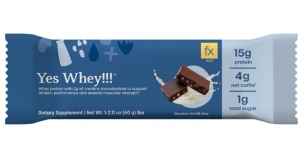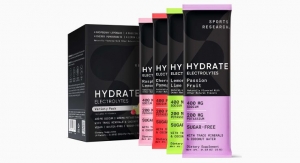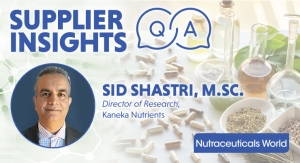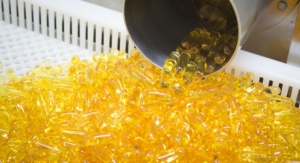Lisa Olivo, Associate Editor06.03.13
The energy segment over the last year experienced an exhilarating high, followed by a subsequent crash back down to Earth.
For companies manufacturing and selling energy supplements, there have certainly been plenty of highs. According to Nutrition Business Journal, Boulder, CO, energy drinks saw a steady rise of 16% in 2012 to become an $8.7 billion market. The energy shot market also grew 3% to $1.7 billion.
This year’s projections from Datamonitor foresee a continued climb, explained Durrell Washington, manager of design and marketing services at ChromaDex, Inc., Irvine, CA. “The U.S. energy drink market is anticipated to be around $19.7 billion this year. The growth is attributed to more private label initiatives, larger container sizes, multi-pack options, sugar-free versions and juice hybrids that taste good,” he said.
This development has much to do with growing popularity among key demographics that are looking for a quick pick-me-up in a can. In 2012 the Journal of Nutrition examined the growing trend of energy drink consumption among teens and children, and found that energy drinks represented 8.8% of the sugary beverages that they drank regularly. Another study from Alcohol Justice, formerly known as the Marin Institute, found that 31% of 12-17 year olds regularly consume energy beverages, compared to 22% of 25-33 year olds.
Packaged Facts, Rockville, MD, has reported a growing interest among Baby Boomers looking to add a little hop to their step. The consumer goods market research firm reported that those 55 years and older, who also happen to represent two thirds of the U.S. population, are emerging as a promising consumer base for these products.
For example, Packaged Facts cited a strong up-tick in the sales of the popular energy shot 5-Hour Energy among older adults. This sales increase led the brand to begin marketing in the pages of the AARP Bulletin in an attempt to reach the broader Boomer audience.
“There are 78 million Baby Boomers now with more than $2 trillion in spending power,” noted Bob Green president of Nutratech, Inc., West Caldwell, NJ. “This is the generation that has driven virtually every significant cultural and marketing trend for the past 50 years. One of their key goals is ‘successful aging’—living longer and healthier, and maintaining their vitality and quality of life.” For some of these aging consumers, an energy supplement may just be the leg up they’re looking for.
With both young and old consumers looking to increase their stamina and vitality with a pill, can, shot or snack, it’s no surprise creators of functional foods, beverages and supplements are latching onto the energy market craze. However, recent scrutiny over increased caffeine consumption among energy supplement users has begun to raise eyebrows among government officials, as well as many within the nutraceutical industry.
Buzz Kill
While the original energy drink, coffee, is a household staple for most people, energy drinks have come under increased media and government criticism recently, as a result of a large number of allegations linking energy product use with serious medical issues, such as heart attacks, convulsions, and in some instances, death.
In November of 2012, 5-Hour Energy made headlines when evidence suggested a link between 92 patient reports, including 13 deaths and 33 hospitalizations. Monster Beverage Corporation, whose energy drinks account for 32% of the market share, according to Packaged Facts (along with Red Bull at 49% and Rockstar Energy Drink at 13%), has also been indicated in similar allegations. These companies are not the only ones whose products are being associated with serious adverse events; and statistics on hospital visits related to energy drink consumption from the U.S. Department of Health and Human Services (HHS) only solidify the public’s growing concern over these products. A recent survey from HHS revealed that emergency room visits related to energy drinks doubled from 10,000 to 20,000 visits between 2007 and 2011. A previous report also found 11% of total emergency room visits related to energy drink consumption involved children ages 12 to 17.
A Consumer Reports assessment from late 2012 also shed light on some of the large quantities of caffeine contained in these shots and drinks, as well as the often-vast discrepancy between actual caffeine content, and how much was indicated on nutritional labels. Titled “The buzz on energy-drink caffeine” the report found, “Caffeine levels per serving ranged from about 6 milligrams to 242 milligrams per serving—and some containers have more than one serving.” Additionally, five of the 16 products that listed a specific caffeine amount contained on average more than 20% of that labeled amount.
Consumer Reports also noted another puzzling issue with many of the beverages reviewed. Eleven of the 17 products didn’t list the caffeine content in their products at all. While this may seem alarming, many of these beverages are classified as dietary supplements rather than beverages, and therefore are not legally required to indicate the amount of caffeine or energy-increasing ingredients in their products.
This loophole has started turning heads on Capitol Hill. Recently, the staff of Congressman Edward Markey (D-MA), in coordination with the staff of Senators Richard Durbin (D-IL) and Richard Blumenthal (D-CT), issued a report titled “What’s all the BUZZ about? A Survey of Popular Energy Drinks Finds Inconsistent Labeling, Questionable Ingredients and Targeted Marketing to Adolescents.”
The congressional investigation found labeling and caffeine content inconsistencies analogous to those reported by Consumer Reports, though the bulk of research detailed energy drink manufacturers’ marketing toward children and adolescents.
The report cited data from the American Academy of Pediatrics (AAP), which stated that “energy drinks have no therapeutic benefit to children” and that the properties of the ingredients in these products “may put some children at risk for adverse health events.” Given the apparent high number of teens and children visiting the emergency room for energy drink induced health events, the congressional committee urged companies to discontinue all marketing of these products to children under 18 years of age. Additionally, the report recommended companies provide clearer ingredient and serving labels; specify if a product contains caffeine amounts above 200 parts per million, and if so, include a warning for pregnant or nursing women, and children under 18; and report to FDA with serious adverse event reports.
Industry trade associations, such as The Council for Responsible Nutrition (CRN), Washington, D.C., have echoed many of these recommendations. Prior to the congressional report, CRN released a series of suggested guidelines for caffeine-containing dietary supplements, emphasizing five core areas: disclosure of total caffeine content from both added and naturally occurring sources of caffeine; label advisories for conditions of use; serving size and daily intake recommendations; restraints against marketing in combination with alcohol; and implementation for product labels.
When asked about the industry’s response thus far to CRN’s recommendations, regulatory counsel for the organization, Rend Al-Mondhiry, commented, “So far it’s been really positive. This was really an effort where our CRN member companies united and wanted to put something together we thought the industry could support, and that was flexible enough for companies within the energy space.”
She further stated, “We support transparency, and want consumers to be able to make choices about caffeine in their diet. That’s why we put together these guidelines—we want companies to be able to provide this information to consumers.”
John Shaw, CEO of the Natural Product Association (NPA), Washington, D.C., commented, “NPA believes that people have a right to know what’s in their food, though we would not prescribe any specific label.” He added, “It’s important to note that caffeine also can be in OTC (over-the-counter) drugs, it’s a legal dietary ingredient for supplements, and it’s Generally Recognized As Safe for foods by the federal government.”
NPA also expects that this focus by Congress and federal regulators will cause companies to look more carefully at their responsibilities under the law regarding these products, according to Mr. Shaw. “We believe that all companies must follow the applicable regulations and we would urge companies to step up their efforts at compliance as needed.”
FDA Investigation & Oversight
Media and government criticism has led FDA to focus on this market, and further investigate the safety of products.
More recently, food and snack offerings with added caffeine have drawn negative attention, and raised red flags at FDA. Offerings such as Jelly Belly’s “Extreme Sport Beans,” which have 50 mg of caffeine per 100 calorie pack; and Arma Energy Snx’s trail mix, chips and other snacks, have led critics to wonder how one can accurately monitor caffeine intake with a multitude of snacks, beverages and other products containing varying (and often inaccurate or undisclosed) amounts of caffeine.
FDA has publicly voiced concern over the increased number of caffeinated products, which Michael Taylor, FDA’s deputy commissioner of foods, described as “beyond anything FDA envisioned” from its original allowance of caffeinated colas in the 1950s. Further, he questioned the convenience of these products, and the potential effects it could have on children’s health, vowing FDA action as needed.
Companies are taking note of FDA’s intent to push back on the proliferation of caffeinated products, leading to a serious overhaul of some product line-ups. For example, FDA’s plans to investigate such products recently led the Wm. Wrigley Jr. Co., a business unit of Mars Inc., McLean, VA, to pull its Alert Energy caffeinated gum from store shelves.
In a statement from the company, Casey Keller, president of Wrigley North America said, “After discussions with the FDA, we have a greater appreciation for its concern about the proliferation of caffeine in the nation’s food supply. There is a need for changes in the regulatory framework to better guide the consumers and the industry about the appropriate level and use of caffeinated products. In an effort to support this process, and out of respect for the FDA, we have paused the production, sales and marketing of Alert. This will give the FDA time to develop a new regulatory framework for the addition of caffeine to food and drinks.”
Like Mars, many manufacturers are taking FDA’s warnings very seriously. Numerous companies have taken the high road in terms of self-regulation, and have begun preemptively preparing for FDA’s future regulatory review of these products.
However, there are those who are concerned that such oversight could lead to slowing market growth. In April of 2013, Morgan Stanley released a report indicating convenience store sales of energy drinks were up 5.9% for the four-week period ending March 16—the preceding four weeks had shown growth of 5.2%, with the 12-week period up 8.1% overall. When compared with data averaging growth from the previous two years, the market growth seems to be stagnating, with past growth at 13.1%, 11.9% and 14.1%, respectively.
Likewise, BevNet.com recounted anecdotal reports from beverage distributors who have been seeing some growth in sales, but on a whole claim to see the market trending downward.
Could the threat of increased government regulation be leading to a decline in this once energetic marketplace?
CRN’s Ms. Al-Mondhiry doesn’t think so. “Because caffeine is such a safe ingredient that has been so well studied, I don’t feel that this investigation will have too much of an impact on those companies using caffeine as an ingredient at levels that we know are safe. I don’t see too many companies changing their practice based on the investigations.”
On the flipside, Mr. Washington of ChromaDex stated, “We expect that the oversight from FDA would result in strict labeling and composition requirements similar to that mandated by Health Canada, which supports a maximum limit for total caffeine of 400 mg per liter with a maximum amount of caffeine of 180 mg per container presented as a single-serve container.”
Rick Kaiser, vice president of sales and marketing at Natreon, Inc., New Brunswick, NJ, hypothesized that FDA oversight could inadvertently improve sales. “The FDA scrutiny could backfire, as curious consumers rush out to try whatever ingredient is under review to be banned, just as ephedra sales jumped dramatically some years ago just before the ingredient was banned.”
Others see FDA’s enforcement in this category as a step in the right direction. Dean Mosca, president of Proprietary Nutritionals Inc. (PNI), Kearny, NJ, noted, “We think it is a very sound, responsible and reasonable move. There are some energy beverages that have too potent a nervous system stimulant effect, which can be dangerous for those who have certain conditions.” However, Mr. Mosca considered the opposing view, asking, “when is over-regulation enough?” He conceded there are “some people who can handle these types of drinks and who do feel they receive an energy benefit from these products. Perhaps the solution is that there needs to be more visible warning or caution language on the packages.”
Nutratech’s Mr. Green was hopeful that these regulations would “force manufacturers to look beyond stimulant-based energy ingredients.” He expressed that alternatives to energy stimulants exist, and may be the new future of this market. “Our world is already very ‘wired’—in every sense of the word,” he said. “Some manufacturers are starting to realize this, but many still need to adjust their mindsets.”
Beyond Caffeine: Natural Energy
While caffeine is generally considered king of the energy market, many other key ingredients play an important role in giving consumers the vitality they crave.
“Sugar is widely used because of its source of rapid energy,” explained Mr. Washington of Chromadex. “Other ingredients commonly incorporated include B vitamins (vitamin B2, or riboflavin; vitamin B3, or niacin; vitamin B6; and vitamin B12) taurine, tyrosine, carnitine, rhodiola rosea and ginseng. It is also not uncommon to see other herbal extracts such as guarana, yerba mate and green tea used as sources of caffeine.”
However, many manufacturers today are looking to diversify their energy portfolio, and are developing innovative ingredients without the use of stimulants. According to PNI’s Mr. Mosca, “there are many other natural energizers that work to provide alertness or extend stamina in different ways that are safer.”
“Today’s energy product market is driven by ingredients that are stimulants affecting the central nervous system such as caffeine, guarana, tyrosine and white willow bark,” said Thomas VonderBrink, president of Bioenergy Life Science, Inc., Minneapolis, MN. “Products made with these ingredients provide a quick energy boost.”
However, he predicted change on the horizon in light of the ongoing regulatory paradigm shift, as well as unwanted side effects such as “the crash that usually occurs 3 to 5 hours after ingestion, as well as their potential side effects if taken in larger doses.” Mr. VonderBrink believes these issues are leading the market to undergo a shift “toward more natural and sustainable forms of energy enhancement, such as those provided by D Ribose and CoQ10.”
While many experts agree the inclusion of natural energy ingredients is key, some see the reduction of caffeine, rather than its elimination, as the best way forward. “We believe ingredients that will allow the reduction of caffeine, without a demonstrable change in the consumer’s experience will be driving the market,” said Mr. Washington. “We believe that doing research on modified versions of caffeine will be the most desirable ingredient solution, as the only other viable option beyond that would be to pursue other natural compounds that would also deliver a similar effect. There are a lot of problems in pursuing new natural compounds, as they would all most likely fit into the same category as DMAA (dimethylamylamine), and would more than likely end up with the same fate,” he added.
FDA recently began halting the sale of DMAA, most commonly used in supplements promising weight loss, muscle building and performance enhancement, by issuing warnings that the ingredient can elevate blood pressure and could lead to cardiovascular problems, including heart attack, shortness of breath and tightening of the chest. Given the known biological activity of DMAA, the ingredient may be particularly dangerous when used with caffeine.
According to Jeff Wuagneux, president and CEO of RFI Ingredients, Blauvelt, NY, “For the most part, consumers perceive caffeine from natural sources to be healthier than energy drinks containing synthetic caffeine and epidemiological studies basically support the safety of caffeine from natural sources.” In addition, he noted, “FDA does not require caffeine to be labeled on products in which the caffeine occurs naturally. So, this translates to additional consumer demand for 1) caffeine-free energy products or 2) ingredients that contain caffeine naturally.”
Ingredients for Vitality
Regardless of their stance, companies are moving to develop the next wave of energy supplements to meet regulatory and consumer demands.
Chromadex has developed PURENERGY, “a co-crystal of pterostilbene and caffeine.” Mr. Washington explained that, “Co-crystallization of caffeine modifies caffeine and slows its metabolism and excretion from the body. This is reflected in the longer half-life of co-crystalized caffeine compared to caffeine (i.e., 8 hours vs. 0.7 to 1.2 hours in rats). Longer half-life allows less frequent dosing because it takes longer for caffeine to be metabolized.”
Nutratech is sourcing the power of thermogenic ingredients, such as its bitter orange extract Advantra Z. The company’s Mr. Green described how Advantra Z works “by increasing thermogenesis to help burn calories and fat. As the calories and fat burn, energy is released. Advantra Z does this without causing negative cardiovascular and central nervous system side effects.”
For those looking to manufacture caffeine-free energy, RFI offers two such ingredients for use in energy formulas. Its product Chocamine is a patented cocoa-based ingredient rich in theobromine, amino acids, nutritional minerals, biogenic amines, anandamides and polyphenols. Mr. Wuagneux noted that “theobromine and caffeine are both xanthine alkaloids, and their stimulant effect results from the same mechanism—the inhibition of adenosine receptors. In humans, the adenosine receptors A1 and A2A have an effect on the heart, regulating myocardial oxygen consumption and coronary blood flow. They also play important roles in the brain, regulating the release of other neurotransmitters such as dopamine and glutamate.” However, theobromine differs from caffeine in that it has a milder stimulant effect and has a longer half-life in the body.
RFI has also developed a proprietary ginseng extract called GS-15, which according to Mr. Wuagneux is “pharmacologically speaking…classified as an adaptogen.” Ginseng is said to help the body manage stress and “achieve homeostatic balance, optimizing the body’s ability to resist fatigue, stress, trauma and support healthy aging and overall wellness,” he explained. RFI believes that “resisting fatigue and stress means indirectly providing energy.”
The chia seed—a popular source of omega 3s, protein and fiber—is a rising star within the natural products space that is also being positioned as an energy ingredient by companies, such as Proprietary Nutritionals. The company’s Benexia omega 3 chia product provides lasting energy via thermogenesis. “Chia seed is actually one of the original energy foods that has been recently rediscovered, so to speak,” explained PNI’s Mr. Mosca. “The ancient Aztecs cultivated it and consumed it expressly for its stamina-supporting properties, notably before going into any battle.”
The body’s natural production of ATP, or adenosine triphosphate, is also an emerging area of exploration within the energy space. ATP, often referred to as the body’s natural “energy currency,” is produced in the body and supplies living cells with the energy needed to stay alive. Several companies such as Van Drunen Farms/FutureCeuticals, Natreon, Inc. and Enzymedica, have developed unique ingredients and supplements that harness the energy of this potent natural chemical.
Hartley Pond, vice president of technical sales at VDF/FutureCeuticals reported that the company is focused on developing new products that stimulate ATP production, such as its elevATP “a proprietary blend of plant-derived trace minerals with a polyphenol-rich apple extract.”
Natreon’s shilajit ingredient PrimaVie, is “a rare tar-like substance from the ancient seabed of what was once the Himalayan ocean,” that works at the cellular level to restore ATP, according to Mr. Kaiser. The company also produces the energy ingredient Rejuven, which consists of a tubular root of a shrub from India.
Venice, FL-based Enzymedica has also launched a new digestive enzyme supplement Digest Gold with ATPro. By including ATP in its digestive supplement, the company aims to decrease the energy demand of the digestive process, since ATP plays a key role in the signaling of timely and complete digestion of food within the gut.
The Road Ahead...
It seems there are more energetic highs and troubling crashes ahead for this tumultuous market. However, with new governmental guidance potentially on the horizon, and industry leaders looking to discover the next wave of safe and effective ingredients, there’s sure to be an abundance of quality products to keep consumers alert, awake and in good health.
Responsible manufacturers and ingredient suppliers agree that providing consumers with accurate information so they can make informed decisions about their health is the right way forward.
“We fully subscribe to the concept that ‘knowledge is power,’ meaning that it behooves consumers to be able to know how much caffeine is in a product,” said PNI’s Mr. Mosca.
Nutratech’s Mr. Green agreed, adding that, “consumer safety has to be the top priority of any energy supplement manufacturer.”
Complaint alleges that marketing targets children.
San Francisco City Attorney Dennis Herrera has sued Monster Beverage Corporation, Corona, CA, for allegedly violating California law with its marketing of highly-caffeinated energy drinks to children as young as six-years-old, despite scientific findings that such products may cause “significant morbidity in adolescents” from elevated blood pressure, brain seizures and severe cardiac events.
The lawsuit filed in San Francisco Superior Court came just one week after Monster pre-emptively sued Mr. Herrera in a legal attempt to halt his office’s months-long investigation into the marketing and sales practices of the nation’s largest energy drink manufacturer. Reportedly, Mr. Herrera’s office had been working with Monster in good faith to negotiate voluntary changes to its youth-targeted marketing practices when the energy drink manufacturer sued the city attorney in federal court on April 29.
Mr. Herrera’s complaint alleges that Monster Beverage Corporation’s business and marketing practices violate California’s Unfair Competition Law and Sherman Food, Drug and Cosmetic Law. If San Francisco’s lawsuit is successful, Monster Energy could be enjoined from continuing conduct deemed harmful to consumers and competitors, and forced to pay significant civil penalties and restitution as a result of its business practices.
For companies manufacturing and selling energy supplements, there have certainly been plenty of highs. According to Nutrition Business Journal, Boulder, CO, energy drinks saw a steady rise of 16% in 2012 to become an $8.7 billion market. The energy shot market also grew 3% to $1.7 billion.
This year’s projections from Datamonitor foresee a continued climb, explained Durrell Washington, manager of design and marketing services at ChromaDex, Inc., Irvine, CA. “The U.S. energy drink market is anticipated to be around $19.7 billion this year. The growth is attributed to more private label initiatives, larger container sizes, multi-pack options, sugar-free versions and juice hybrids that taste good,” he said.
This development has much to do with growing popularity among key demographics that are looking for a quick pick-me-up in a can. In 2012 the Journal of Nutrition examined the growing trend of energy drink consumption among teens and children, and found that energy drinks represented 8.8% of the sugary beverages that they drank regularly. Another study from Alcohol Justice, formerly known as the Marin Institute, found that 31% of 12-17 year olds regularly consume energy beverages, compared to 22% of 25-33 year olds.
Packaged Facts, Rockville, MD, has reported a growing interest among Baby Boomers looking to add a little hop to their step. The consumer goods market research firm reported that those 55 years and older, who also happen to represent two thirds of the U.S. population, are emerging as a promising consumer base for these products.
For example, Packaged Facts cited a strong up-tick in the sales of the popular energy shot 5-Hour Energy among older adults. This sales increase led the brand to begin marketing in the pages of the AARP Bulletin in an attempt to reach the broader Boomer audience.
“There are 78 million Baby Boomers now with more than $2 trillion in spending power,” noted Bob Green president of Nutratech, Inc., West Caldwell, NJ. “This is the generation that has driven virtually every significant cultural and marketing trend for the past 50 years. One of their key goals is ‘successful aging’—living longer and healthier, and maintaining their vitality and quality of life.” For some of these aging consumers, an energy supplement may just be the leg up they’re looking for.
With both young and old consumers looking to increase their stamina and vitality with a pill, can, shot or snack, it’s no surprise creators of functional foods, beverages and supplements are latching onto the energy market craze. However, recent scrutiny over increased caffeine consumption among energy supplement users has begun to raise eyebrows among government officials, as well as many within the nutraceutical industry.
Buzz Kill
While the original energy drink, coffee, is a household staple for most people, energy drinks have come under increased media and government criticism recently, as a result of a large number of allegations linking energy product use with serious medical issues, such as heart attacks, convulsions, and in some instances, death.
In November of 2012, 5-Hour Energy made headlines when evidence suggested a link between 92 patient reports, including 13 deaths and 33 hospitalizations. Monster Beverage Corporation, whose energy drinks account for 32% of the market share, according to Packaged Facts (along with Red Bull at 49% and Rockstar Energy Drink at 13%), has also been indicated in similar allegations. These companies are not the only ones whose products are being associated with serious adverse events; and statistics on hospital visits related to energy drink consumption from the U.S. Department of Health and Human Services (HHS) only solidify the public’s growing concern over these products. A recent survey from HHS revealed that emergency room visits related to energy drinks doubled from 10,000 to 20,000 visits between 2007 and 2011. A previous report also found 11% of total emergency room visits related to energy drink consumption involved children ages 12 to 17.
A Consumer Reports assessment from late 2012 also shed light on some of the large quantities of caffeine contained in these shots and drinks, as well as the often-vast discrepancy between actual caffeine content, and how much was indicated on nutritional labels. Titled “The buzz on energy-drink caffeine” the report found, “Caffeine levels per serving ranged from about 6 milligrams to 242 milligrams per serving—and some containers have more than one serving.” Additionally, five of the 16 products that listed a specific caffeine amount contained on average more than 20% of that labeled amount.
Consumer Reports also noted another puzzling issue with many of the beverages reviewed. Eleven of the 17 products didn’t list the caffeine content in their products at all. While this may seem alarming, many of these beverages are classified as dietary supplements rather than beverages, and therefore are not legally required to indicate the amount of caffeine or energy-increasing ingredients in their products.
This loophole has started turning heads on Capitol Hill. Recently, the staff of Congressman Edward Markey (D-MA), in coordination with the staff of Senators Richard Durbin (D-IL) and Richard Blumenthal (D-CT), issued a report titled “What’s all the BUZZ about? A Survey of Popular Energy Drinks Finds Inconsistent Labeling, Questionable Ingredients and Targeted Marketing to Adolescents.”
The congressional investigation found labeling and caffeine content inconsistencies analogous to those reported by Consumer Reports, though the bulk of research detailed energy drink manufacturers’ marketing toward children and adolescents.
The report cited data from the American Academy of Pediatrics (AAP), which stated that “energy drinks have no therapeutic benefit to children” and that the properties of the ingredients in these products “may put some children at risk for adverse health events.” Given the apparent high number of teens and children visiting the emergency room for energy drink induced health events, the congressional committee urged companies to discontinue all marketing of these products to children under 18 years of age. Additionally, the report recommended companies provide clearer ingredient and serving labels; specify if a product contains caffeine amounts above 200 parts per million, and if so, include a warning for pregnant or nursing women, and children under 18; and report to FDA with serious adverse event reports.
Industry trade associations, such as The Council for Responsible Nutrition (CRN), Washington, D.C., have echoed many of these recommendations. Prior to the congressional report, CRN released a series of suggested guidelines for caffeine-containing dietary supplements, emphasizing five core areas: disclosure of total caffeine content from both added and naturally occurring sources of caffeine; label advisories for conditions of use; serving size and daily intake recommendations; restraints against marketing in combination with alcohol; and implementation for product labels.
When asked about the industry’s response thus far to CRN’s recommendations, regulatory counsel for the organization, Rend Al-Mondhiry, commented, “So far it’s been really positive. This was really an effort where our CRN member companies united and wanted to put something together we thought the industry could support, and that was flexible enough for companies within the energy space.”
She further stated, “We support transparency, and want consumers to be able to make choices about caffeine in their diet. That’s why we put together these guidelines—we want companies to be able to provide this information to consumers.”
John Shaw, CEO of the Natural Product Association (NPA), Washington, D.C., commented, “NPA believes that people have a right to know what’s in their food, though we would not prescribe any specific label.” He added, “It’s important to note that caffeine also can be in OTC (over-the-counter) drugs, it’s a legal dietary ingredient for supplements, and it’s Generally Recognized As Safe for foods by the federal government.”
NPA also expects that this focus by Congress and federal regulators will cause companies to look more carefully at their responsibilities under the law regarding these products, according to Mr. Shaw. “We believe that all companies must follow the applicable regulations and we would urge companies to step up their efforts at compliance as needed.”
FDA Investigation & Oversight
Media and government criticism has led FDA to focus on this market, and further investigate the safety of products.
More recently, food and snack offerings with added caffeine have drawn negative attention, and raised red flags at FDA. Offerings such as Jelly Belly’s “Extreme Sport Beans,” which have 50 mg of caffeine per 100 calorie pack; and Arma Energy Snx’s trail mix, chips and other snacks, have led critics to wonder how one can accurately monitor caffeine intake with a multitude of snacks, beverages and other products containing varying (and often inaccurate or undisclosed) amounts of caffeine.
FDA has publicly voiced concern over the increased number of caffeinated products, which Michael Taylor, FDA’s deputy commissioner of foods, described as “beyond anything FDA envisioned” from its original allowance of caffeinated colas in the 1950s. Further, he questioned the convenience of these products, and the potential effects it could have on children’s health, vowing FDA action as needed.
Companies are taking note of FDA’s intent to push back on the proliferation of caffeinated products, leading to a serious overhaul of some product line-ups. For example, FDA’s plans to investigate such products recently led the Wm. Wrigley Jr. Co., a business unit of Mars Inc., McLean, VA, to pull its Alert Energy caffeinated gum from store shelves.
In a statement from the company, Casey Keller, president of Wrigley North America said, “After discussions with the FDA, we have a greater appreciation for its concern about the proliferation of caffeine in the nation’s food supply. There is a need for changes in the regulatory framework to better guide the consumers and the industry about the appropriate level and use of caffeinated products. In an effort to support this process, and out of respect for the FDA, we have paused the production, sales and marketing of Alert. This will give the FDA time to develop a new regulatory framework for the addition of caffeine to food and drinks.”
Like Mars, many manufacturers are taking FDA’s warnings very seriously. Numerous companies have taken the high road in terms of self-regulation, and have begun preemptively preparing for FDA’s future regulatory review of these products.
However, there are those who are concerned that such oversight could lead to slowing market growth. In April of 2013, Morgan Stanley released a report indicating convenience store sales of energy drinks were up 5.9% for the four-week period ending March 16—the preceding four weeks had shown growth of 5.2%, with the 12-week period up 8.1% overall. When compared with data averaging growth from the previous two years, the market growth seems to be stagnating, with past growth at 13.1%, 11.9% and 14.1%, respectively.
Likewise, BevNet.com recounted anecdotal reports from beverage distributors who have been seeing some growth in sales, but on a whole claim to see the market trending downward.
Could the threat of increased government regulation be leading to a decline in this once energetic marketplace?
CRN’s Ms. Al-Mondhiry doesn’t think so. “Because caffeine is such a safe ingredient that has been so well studied, I don’t feel that this investigation will have too much of an impact on those companies using caffeine as an ingredient at levels that we know are safe. I don’t see too many companies changing their practice based on the investigations.”
On the flipside, Mr. Washington of ChromaDex stated, “We expect that the oversight from FDA would result in strict labeling and composition requirements similar to that mandated by Health Canada, which supports a maximum limit for total caffeine of 400 mg per liter with a maximum amount of caffeine of 180 mg per container presented as a single-serve container.”
Rick Kaiser, vice president of sales and marketing at Natreon, Inc., New Brunswick, NJ, hypothesized that FDA oversight could inadvertently improve sales. “The FDA scrutiny could backfire, as curious consumers rush out to try whatever ingredient is under review to be banned, just as ephedra sales jumped dramatically some years ago just before the ingredient was banned.”
Others see FDA’s enforcement in this category as a step in the right direction. Dean Mosca, president of Proprietary Nutritionals Inc. (PNI), Kearny, NJ, noted, “We think it is a very sound, responsible and reasonable move. There are some energy beverages that have too potent a nervous system stimulant effect, which can be dangerous for those who have certain conditions.” However, Mr. Mosca considered the opposing view, asking, “when is over-regulation enough?” He conceded there are “some people who can handle these types of drinks and who do feel they receive an energy benefit from these products. Perhaps the solution is that there needs to be more visible warning or caution language on the packages.”
Nutratech’s Mr. Green was hopeful that these regulations would “force manufacturers to look beyond stimulant-based energy ingredients.” He expressed that alternatives to energy stimulants exist, and may be the new future of this market. “Our world is already very ‘wired’—in every sense of the word,” he said. “Some manufacturers are starting to realize this, but many still need to adjust their mindsets.”
Beyond Caffeine: Natural Energy
While caffeine is generally considered king of the energy market, many other key ingredients play an important role in giving consumers the vitality they crave.
“Sugar is widely used because of its source of rapid energy,” explained Mr. Washington of Chromadex. “Other ingredients commonly incorporated include B vitamins (vitamin B2, or riboflavin; vitamin B3, or niacin; vitamin B6; and vitamin B12) taurine, tyrosine, carnitine, rhodiola rosea and ginseng. It is also not uncommon to see other herbal extracts such as guarana, yerba mate and green tea used as sources of caffeine.”
However, many manufacturers today are looking to diversify their energy portfolio, and are developing innovative ingredients without the use of stimulants. According to PNI’s Mr. Mosca, “there are many other natural energizers that work to provide alertness or extend stamina in different ways that are safer.”
“Today’s energy product market is driven by ingredients that are stimulants affecting the central nervous system such as caffeine, guarana, tyrosine and white willow bark,” said Thomas VonderBrink, president of Bioenergy Life Science, Inc., Minneapolis, MN. “Products made with these ingredients provide a quick energy boost.”
However, he predicted change on the horizon in light of the ongoing regulatory paradigm shift, as well as unwanted side effects such as “the crash that usually occurs 3 to 5 hours after ingestion, as well as their potential side effects if taken in larger doses.” Mr. VonderBrink believes these issues are leading the market to undergo a shift “toward more natural and sustainable forms of energy enhancement, such as those provided by D Ribose and CoQ10.”
While many experts agree the inclusion of natural energy ingredients is key, some see the reduction of caffeine, rather than its elimination, as the best way forward. “We believe ingredients that will allow the reduction of caffeine, without a demonstrable change in the consumer’s experience will be driving the market,” said Mr. Washington. “We believe that doing research on modified versions of caffeine will be the most desirable ingredient solution, as the only other viable option beyond that would be to pursue other natural compounds that would also deliver a similar effect. There are a lot of problems in pursuing new natural compounds, as they would all most likely fit into the same category as DMAA (dimethylamylamine), and would more than likely end up with the same fate,” he added.
FDA recently began halting the sale of DMAA, most commonly used in supplements promising weight loss, muscle building and performance enhancement, by issuing warnings that the ingredient can elevate blood pressure and could lead to cardiovascular problems, including heart attack, shortness of breath and tightening of the chest. Given the known biological activity of DMAA, the ingredient may be particularly dangerous when used with caffeine.
According to Jeff Wuagneux, president and CEO of RFI Ingredients, Blauvelt, NY, “For the most part, consumers perceive caffeine from natural sources to be healthier than energy drinks containing synthetic caffeine and epidemiological studies basically support the safety of caffeine from natural sources.” In addition, he noted, “FDA does not require caffeine to be labeled on products in which the caffeine occurs naturally. So, this translates to additional consumer demand for 1) caffeine-free energy products or 2) ingredients that contain caffeine naturally.”
Ingredients for Vitality
Regardless of their stance, companies are moving to develop the next wave of energy supplements to meet regulatory and consumer demands.
Chromadex has developed PURENERGY, “a co-crystal of pterostilbene and caffeine.” Mr. Washington explained that, “Co-crystallization of caffeine modifies caffeine and slows its metabolism and excretion from the body. This is reflected in the longer half-life of co-crystalized caffeine compared to caffeine (i.e., 8 hours vs. 0.7 to 1.2 hours in rats). Longer half-life allows less frequent dosing because it takes longer for caffeine to be metabolized.”
Nutratech is sourcing the power of thermogenic ingredients, such as its bitter orange extract Advantra Z. The company’s Mr. Green described how Advantra Z works “by increasing thermogenesis to help burn calories and fat. As the calories and fat burn, energy is released. Advantra Z does this without causing negative cardiovascular and central nervous system side effects.”
For those looking to manufacture caffeine-free energy, RFI offers two such ingredients for use in energy formulas. Its product Chocamine is a patented cocoa-based ingredient rich in theobromine, amino acids, nutritional minerals, biogenic amines, anandamides and polyphenols. Mr. Wuagneux noted that “theobromine and caffeine are both xanthine alkaloids, and their stimulant effect results from the same mechanism—the inhibition of adenosine receptors. In humans, the adenosine receptors A1 and A2A have an effect on the heart, regulating myocardial oxygen consumption and coronary blood flow. They also play important roles in the brain, regulating the release of other neurotransmitters such as dopamine and glutamate.” However, theobromine differs from caffeine in that it has a milder stimulant effect and has a longer half-life in the body.
RFI has also developed a proprietary ginseng extract called GS-15, which according to Mr. Wuagneux is “pharmacologically speaking…classified as an adaptogen.” Ginseng is said to help the body manage stress and “achieve homeostatic balance, optimizing the body’s ability to resist fatigue, stress, trauma and support healthy aging and overall wellness,” he explained. RFI believes that “resisting fatigue and stress means indirectly providing energy.”
The chia seed—a popular source of omega 3s, protein and fiber—is a rising star within the natural products space that is also being positioned as an energy ingredient by companies, such as Proprietary Nutritionals. The company’s Benexia omega 3 chia product provides lasting energy via thermogenesis. “Chia seed is actually one of the original energy foods that has been recently rediscovered, so to speak,” explained PNI’s Mr. Mosca. “The ancient Aztecs cultivated it and consumed it expressly for its stamina-supporting properties, notably before going into any battle.”
The body’s natural production of ATP, or adenosine triphosphate, is also an emerging area of exploration within the energy space. ATP, often referred to as the body’s natural “energy currency,” is produced in the body and supplies living cells with the energy needed to stay alive. Several companies such as Van Drunen Farms/FutureCeuticals, Natreon, Inc. and Enzymedica, have developed unique ingredients and supplements that harness the energy of this potent natural chemical.
Hartley Pond, vice president of technical sales at VDF/FutureCeuticals reported that the company is focused on developing new products that stimulate ATP production, such as its elevATP “a proprietary blend of plant-derived trace minerals with a polyphenol-rich apple extract.”
Natreon’s shilajit ingredient PrimaVie, is “a rare tar-like substance from the ancient seabed of what was once the Himalayan ocean,” that works at the cellular level to restore ATP, according to Mr. Kaiser. The company also produces the energy ingredient Rejuven, which consists of a tubular root of a shrub from India.
Venice, FL-based Enzymedica has also launched a new digestive enzyme supplement Digest Gold with ATPro. By including ATP in its digestive supplement, the company aims to decrease the energy demand of the digestive process, since ATP plays a key role in the signaling of timely and complete digestion of food within the gut.
The Road Ahead...
It seems there are more energetic highs and troubling crashes ahead for this tumultuous market. However, with new governmental guidance potentially on the horizon, and industry leaders looking to discover the next wave of safe and effective ingredients, there’s sure to be an abundance of quality products to keep consumers alert, awake and in good health.
Responsible manufacturers and ingredient suppliers agree that providing consumers with accurate information so they can make informed decisions about their health is the right way forward.
“We fully subscribe to the concept that ‘knowledge is power,’ meaning that it behooves consumers to be able to know how much caffeine is in a product,” said PNI’s Mr. Mosca.
Nutratech’s Mr. Green agreed, adding that, “consumer safety has to be the top priority of any energy supplement manufacturer.”
Complaint alleges that marketing targets children.
San Francisco City Attorney Dennis Herrera has sued Monster Beverage Corporation, Corona, CA, for allegedly violating California law with its marketing of highly-caffeinated energy drinks to children as young as six-years-old, despite scientific findings that such products may cause “significant morbidity in adolescents” from elevated blood pressure, brain seizures and severe cardiac events.
The lawsuit filed in San Francisco Superior Court came just one week after Monster pre-emptively sued Mr. Herrera in a legal attempt to halt his office’s months-long investigation into the marketing and sales practices of the nation’s largest energy drink manufacturer. Reportedly, Mr. Herrera’s office had been working with Monster in good faith to negotiate voluntary changes to its youth-targeted marketing practices when the energy drink manufacturer sued the city attorney in federal court on April 29.
Mr. Herrera’s complaint alleges that Monster Beverage Corporation’s business and marketing practices violate California’s Unfair Competition Law and Sherman Food, Drug and Cosmetic Law. If San Francisco’s lawsuit is successful, Monster Energy could be enjoined from continuing conduct deemed harmful to consumers and competitors, and forced to pay significant civil penalties and restitution as a result of its business practices.



























